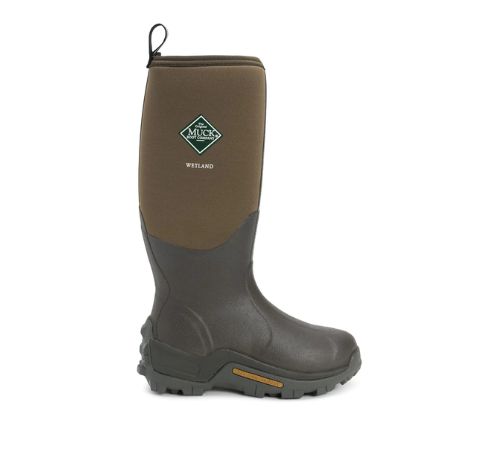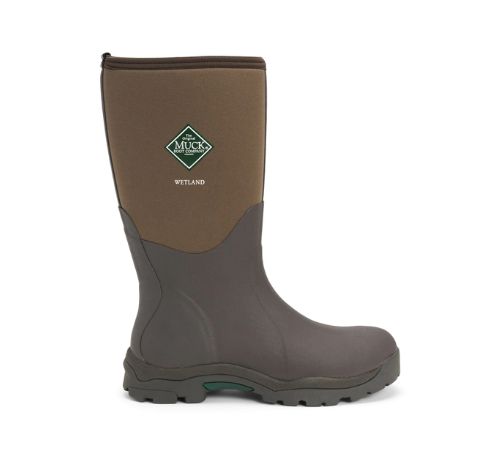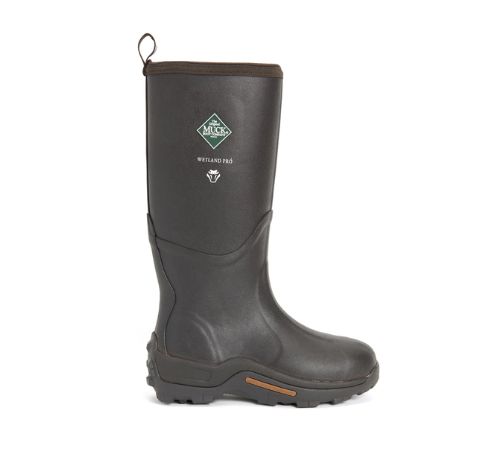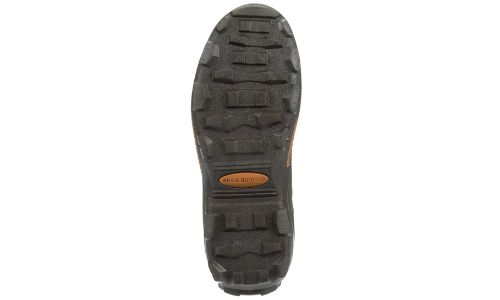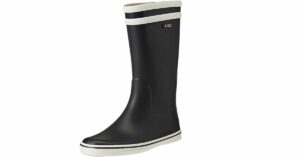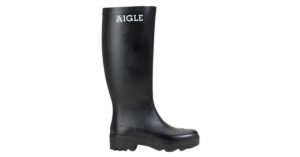Muck Wetland Boots Review
Tall protective neoprene lined rain boots for men & women
The Wetland boots are a premium work boot keeping you warm, dry and protected in the harshest of conditions. A stretch fit top binding and neoprene insulating lining keeps warmth in and cold out. The durable outsole and thick rubber provides protection from sharp objects.
Muck Wetland Rain Boots Review
Date of review June 2022 by Richard
Our Verdict
| WHAT WE LIKE | WHAT WE DON’T LIKE |
| + Excellent quality | – Bland style |
| + Neoprene lining (keep feet warm) | – A bit pricey |
| + Surprisingly lightweight | |
| + Good construction |
Features: Wetland Boots
- Adjustments: On some styles
- Special features: 100% waterproof
- Inside material: Neoprene
- Outside material: Rubber \ Neoprene
- Fit wide calves: Yes (not suitable for extra wide calves)
- Heel Type: 3cm block heel
- Waterproof: 100% waterproof
- Colours: Brown and bark
- Sizes (unisex): 4 UK to 14 UK – 5 US to 15 US
The Wetland boots are among Muck’s best selling footwear. They’re more expensive when compared to completing brands, but are they worth the extra cost? In this review we take a look at the features, benefits, and drawbacks to help you decide if they’re right for you.
The different styles of the Muck Wetland boots
There are four different styles of the Wetland boots. They’re all tall boots and look very similar, but there are some subtle differences.
Unisex Wetland Tall Boots
As the name suggests the boots are suitable for both men and women and are available in sizes 4 UK to 14 UK – 5 US to 15 US. They have an average height of 44cm \ 18″, which for most people means that they will nearly cover the top of the calves. The stretchy neoprene at the top of the boots makes them suitable for people with wider calves, up to a maximum of 43cm \ 17. On average the Unisex Wetland boots weigh 2.1kg \ 4.75lbs.
One of the benefits of having the top half of the boots made from neoprene rather than rubber, is that they can be rolled down to make short boots.
Women's Wetland Tall Boots
These boots are considerably shorter than the other styles, with an average boot height of 36cm \ 15″, which will typically be about halfway up the calves. They are available in sizes 4 UK to 9 UK – 6 US to 11 US and have a maximum calf circumference of 41.5cm \ 17″, making them suitable for ladies with wide calves. The boots have been styled with a much less bulky look. An average pair of the Women’s Wetland boots weigh about 1.1kg \ 2.4lbs, which is lightweight for this style of boot.
Men's Wetland Pro Boots
Unlike the other styles of Wetland boots, the Pro boots have rubber the entire length of the shaft. This gives additional protection against objects that could potentially cause injury This additional protection does increase the weight of the boots to about 3kg \ 6.6 lbs (both boots). The boots are approximately 43cm \ 17″ high and have a maximum calf circumference of 42.5cm \ 16.8″. They are available in 6 UK to 14 UK – 6.5 US to 14.5 US
Adjustable Wetland Tall Boots
The adjustable boots are similar to the unisex boots in terms of height and look, but they have an additional toggle at the top that allows you to adjust the fit. The adjustable gusset extends up to 7cm \ 3″, giving the men’s Adjustable Wetland boots a maximum calf circumference of 43cm \ 17.3″ and the women’s 41.5cm \ 17″. The average height of the boots is 44cm \ 18″ for men’s boots and 36cm \ 15″ for the women’s boots.
The Men’s boots are available in sizes 6 UK to 14 UK – 6.5 US to 14.5 US. The women’s boots are available in 3 UK to 9 UK – 5 US to 11 US.
How comfortable are Wetland boots
One of the main reasons that people choose Muck boots over more traditional rubber boots, is comfort. The Muck wetland boots are designed to be comfortable enough to wear all day. The neoprene is stretchy and moulds to the shape of your feet and calves and thanks to the slightly spongy nature the neoprene lining also provides cushioning and shock absorption.
One problem of the main problems with rubber boots is that rubber doesn’t breathe. This means that heat and moisture (sweat) can build up in the boots and cause discomfort. To get around this problem Muck Wetland boots have a sponge like lining covering the neoprene, that as you move acts like bellows, moving air around the boots. This helps control heat and moisture, making the boots more comfortable than your typical rubber boot.
The boots are much more lightweight that you might expect. If you’re only going to be wearing the boots for short periods of time, weight isn’t usually much of a concern. But, if you’re going to be wearing the boots all day it can make a big difference to how tired you’re feet get.
How warm are they
All four styles of Wetland boots have a 5mm neoprene, which provides a decent layer of insulation from the cold. Muck have rated the boots for use between -30 °C to 10 °C \ -20 °F to 50 °F. In reality, wearing these boots for any length of time in -30 °C \ -20 °F is going to equal cold feet.
Other than the neoprene lining to keep feet warm, the boots have thick rubber outsoles which help prevents the cold coming up from the ground.
The insoles of the boots are disappointingly thin and provide very little in the way of insulation. On the plus side, the insole can easily be removed and replaced with your own insole if required.
How good is the traction
In short, the the Wetland boots have excellent grip.
The soles have deep treads that sink down into soft surfaces, such as mud and snow, giving very good traction. Minimising the amount slipping and so reducing the chance of falling over. The spacing between the lugs also help to clear mud and debris as you walk, ensuring continued grip.
The soles of the boots are made from a special compound that is designed to maintain flexibility in cold temperatures. This means that they will remain grippy even when it’s cold outside.
Are they good looking \ stylish
The design of the boot is functional rather than stylish. They are designed to keep your feet dry, protected and warm, rather than look good. That’s not to say that they are ugly, but they probably aren’t going to turn heads when you’re wearing them.
The boots are only available in one colour, which is basically brown. Muck Boots call this brown colour ‘bark’. It’s a shame that they don’t offer the boots in a wider range of colours, as it would make a big difference to how the boots look.
Final Thoughts: Muck Wetland Boots Review
So, what are our final thoughts on Muck Wetland boots?
Overall, we were very impressed with the boots. They are extremely comfortable, thanks to the neoprene lining and sponge like material that helps control heat and moisture. The boots are also very lightweight considering their size and provide excellent grip in both wet and dry conditions.
The main downside to the boots is that they’re a bit bland looking and only available in one colour (bark), a wider range of colours would be nice. But, if you’re looking for a functional boot that will keep your feet dry, protected and warm, then the Muck Wetland boots are a great choice.
BEST SELLING WETLAND BOOTS
Last update on 2025-07-03 / Affiliate links / Images from Amazon Product Advertising API
Questions and Answers: Muck Wetland Boots
Are they any good for snow?
Yes, the boots have a neoprene lining to keep feet warm and have deep treads which sink into the snow providing frip
How do i clean the boots?
Simply clean the rubber and neoprene with warm water and a mild detergent after use. Don’t be tempted to use strong detergents or chemicals since they might harm the natural rubber boots are constructed of.
Can Wetland boots be used as safety boots?
While the Wetland boots do provide excellent protection from the elements, they do not have any safety features such as steel toe caps.
Is the neoprene part of the boots waterproof?
Yes, the neoprene is 100% waterproof
Will my feet get hot wearing the Muck Wetland boots?
The boots are designed for colder weather as they have a 5mm neoprene insulating lining.
The boots have a lining that helps move air around the boots to prevent feet from getting too hot.
Alternative boots to Muck Wetland
Last update on 2025-07-06 / Affiliate links / Images from Amazon Product Advertising API

Richard Cutts
I've been working with rubber boots (aka rain boots, wellies) in one way or another, since 2009. So, i've seen a lot of wellington boots in my time. I create most of the content for the website, which i hope you find useful.
Wellieboots.com NEWSLETTER
Sign up to get the latest reviews, news, tips and where to get the best wellie deals!
You will only get emails from wellieboots.com (no 3rd parties)
We generally send one email per month


